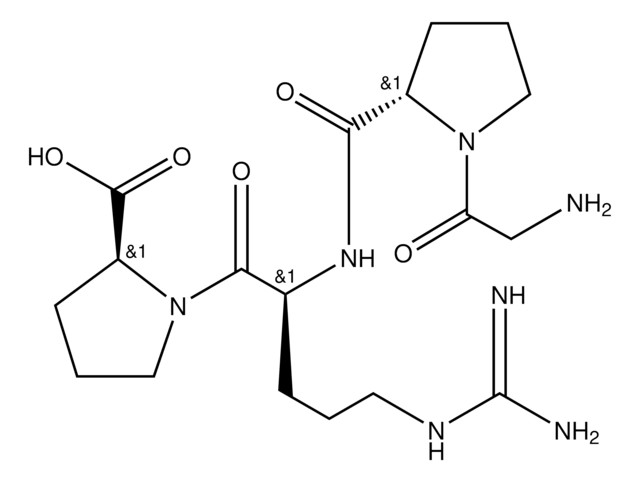T5816
Tricine
BioPerformance Certified, suitable for cell culture, ≥99% (titration)
Synonym(s):
2-[[1,3-Dihydroxy-2-(hydroxymethyl)propan-2-yl]amino]acetic acid, N-[Tris(hydroxymethyl)methyl]glycine, N-[Tris(hydroxymethyl)methyl]glycine
About This Item
Recommended Products
grade
BioPerformance Certified
Assay
≥99% (titration)
form
crystalline powder
storage condition
dry at room temperature
technique(s)
cell culture | mammalian: suitable
impurities
endotoxin and total aerobic microbial count, tested
color
white
useful pH range
7.4-8.8
pKa (25 °C)
8.1
mp
187 °C
cation traces
heavy metals (as Pb): ≤5 ppm
absorption
≤0.02 at 290 at 20%
application(s)
diagnostic assay manufacturing
general analytical
life science and biopharma
sample preparation
SMILES string
OCC(CO)(CO)NCC(O)=O
InChI
1S/C6H13NO5/c8-2-6(3-9,4-10)7-1-5(11)12/h7-10H,1-4H2,(H,11,12)
InChI key
SEQKRHFRPICQDD-UHFFFAOYSA-N
Looking for similar products? Visit Product Comparison Guide
General description
Application
Features and Benefits
- Suitable as a Buffer component, for Electrophoresis and Protein separation
- Effective Buffering from pH 7.4-8.8 (25 °C) with a pKa of 8.1 (25 °C)
- Tested for Endotoxins and Total Aerobic Microbial Count
- Tested to confirm low levels of heavy metal contamination, ensuring suitability for various applications
Other Notes
Storage Class Code
13 - Non Combustible Solids
WGK
WGK 3
Flash Point(F)
Not applicable
Flash Point(C)
Not applicable
Personal Protective Equipment
Certificates of Analysis (COA)
Search for Certificates of Analysis (COA) by entering the products Lot/Batch Number. Lot and Batch Numbers can be found on a product’s label following the words ‘Lot’ or ‘Batch’.
Already Own This Product?
Find documentation for the products that you have recently purchased in the Document Library.
Customers Also Viewed
Our team of scientists has experience in all areas of research including Life Science, Material Science, Chemical Synthesis, Chromatography, Analytical and many others.
Contact Technical Service









